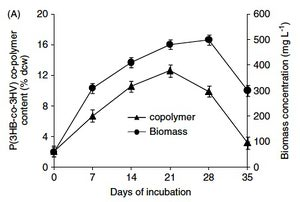Nostoc muscorum: Difference between revisions
| Line 51: | Line 51: | ||
<i>Journal of the Arizona Academy of Science</i>. 1960. Volume 1, No. 3. p. 85-88.] | <i>Journal of the Arizona Academy of Science</i>. 1960. Volume 1, No. 3. p. 85-88.] | ||
[http://mic.sgmjournals.org/content/35/3/447.abstract N | [http://pcp.oxfordjournals.org/content/22/2/185 Isono.T and Fujita.Y "Studies on Morphological Changes of the Blue-green Alga Nostoc muscorum A with Special Reference to the Role of Light". <ii>Plant & Cell Physiology</i>. 1981. Volume 22, No. 2. p. 185-195.] | ||
[http://mic.sgmjournals.org/content/35/3/447.abstract Lazaroff. N, and Vishniac. W “The Relationship of Cellular Differentiation to Colonial Morphogenesis of the Blue-green Alga, Nostoc muscorum A” <i>Microbiology</i> 1964. volume 35, No. 3 p. 447-457] | |||
[http://www.springerlink.com/content/h2r240mq5n17n115/ Rogers, S.L. and Burns, R.G. "Changes in aggregate stability, nutrient status, indigenous microbial populations, and seedling emergence, following inoculation of soil with Nostoc muscorum". <i>Biology and Fertility of Soils</i>. 1994. Volume 18, No. 3. p. 209-215.] | [http://www.springerlink.com/content/h2r240mq5n17n115/ Rogers, S.L. and Burns, R.G. "Changes in aggregate stability, nutrient status, indigenous microbial populations, and seedling emergence, following inoculation of soil with Nostoc muscorum". <i>Biology and Fertility of Soils</i>. 1994. Volume 18, No. 3. p. 209-215.] | ||
Revision as of 16:23, 14 April 2012
Classification
Domain: Bacteria
Phylum: Cyanobacteria
Class: Cyanophyceae
Order: Nostocales
Family: Nostocaceae
Genus: Nostoc
Species
|
NCBI: Taxonomy |
Genus species
Description and Significance
Nostoc muscorum is a free-living microorganism which inhabits both terrestrial and freshwater aquatic environments (Cameron, 1960) (Blumwald & Tel-Or, 1982). N. muscorum cells are filamentous, gram-negative green-brown colored algal cells which can form spores under desiccation conditions (Allison et al., 1937). As cyanobacteria, these organisms are phototrophic, performing photosynthesis in their environments and also fixing atmospheric nitrogen (Blumwald & Tel-Or, 1982).
The ideal environment for Nostoc muscorum is one with pH in the range of 7.0 to 8.5. These organisms cannot tolerate a pH lower than 5.7 (Allison et al., 1937). N. muscorum grows best when light intensity is less than that of direct sunlight, but can continue to grow and fix nitrogen for months in the presence of glucose and absence of sunlight. (Allison et al., 1937)

Nostoc muscorum are important for the nutrient cycling of carbon and nitrogen within the soil ecosystems in which they are found. Inoculation with this species has been shown to increase soil C content by 50-63% and N content by 111-120% as compared with uninoculated soil. (Rogers and Burns, 1993) The process of fixing atmospheric nitrogen contributes plant-available nitrogen to the soil, improving plant growth (Rogers and Burns, 1993).
Soils inoculated with N. muscorum also show an increase in soil aggregate resistance to degradation during wetting and physical disruption. (Rogers and Burns, 1993) This soil stability contribution can help prevent soil erosion, contributing to a higher success of seedling emergence in soils containing N. muscorum compared to those without it (Rogers and Burns, 1993) (Cameron, 1960). The aggregate-forming contributions of the microorganism also helps prevent desertification or the erosion of desert soils, where it is often present as part of cyanobacterial algal crusts (Cameron, 1960).
Current research with Nostoc muscorum involves manipulating the cells’ formation of poly (3-hydroxybutyrate) (PHB) and poly(3-hydroxybutyrate-co-3-hydroxyvalerate) [P(3HB-co-3HV)] co-polymer as potential materials to use in bioplastics for general and medical applications (Bhati and Mallick, 2012). Nostoc muscorum has the potential to be used in industrial settings which produce CO2 waste by using this waste as fuel under propionate- or valerate-supplemented conditions to form the above polymers for thermoplastic formation (Bhati and Mallick, 2012).
Genome Structure
Describe the size and content of the genome. How many chromosomes? Circular or linear? Other interesting features? What is known about its sequence?
Cell Structure, Metabolism and Life Cycle
Interesting features of cell structure; how it gains energy; what important molecules it produces.
Ecology and Pathogenesis
Habitat; symbiosis; biogeochemical significance; contributions to environment.
If relevant, how does this organism cause disease? Human, animal, plant hosts? Virulence factors, as well as patient symptoms.
References
[http://www.jstor.org/stable/40025031 Cameron, R.E. "Communities of Soil Algae Occurring in the Sonoran Desert in Arizona". Journal of the Arizona Academy of Science. 1960. Volume 1, No. 3. p. 85-88.]
Author
Page authored by _____, student of Prof. Jay Lennon at Michigan State University.
<-- Do not remove this line-->
